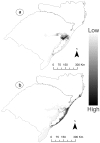Genetic pool information reflects highly suitable areas: the case of two parapatric endangered species of Tuco-tucos (Rodentia: Ctenomiydae)
- PMID: 24819251
- PMCID: PMC4018344
- DOI: 10.1371/journal.pone.0097301
Genetic pool information reflects highly suitable areas: the case of two parapatric endangered species of Tuco-tucos (Rodentia: Ctenomiydae)
Abstract
Conservation of small mammals requires knowledge of the genetically and ecologically meaningful spatial scales at which species respond to habitat modifications. Conservation strategies can be improved through the use of ecological niche models and genetic data to classify areas of high environmental suitability. In this study, we applied a Maxent model integrated with genetic information (nucleotide diversity, haplotype diversity and Fu's Fs neutrality tests) to evaluate potential genetic pool populations with highly suitable areas for two parapatric endangered species of tuco-tucos (Ctenomys minutus and C. lami). Our results demonstrated that both species were largely influenced by vegetation and soil variables at a landscape scale and inhabit a highly specific niche. Ctenomys minutus was also influenced by the variable altitude; the species was associated with low altitudes (sea level). Our model of genetic data associated with environmental suitability indicate that the genetic pool data were associated with highly suitable areas for C. minutus. This pattern was not evident for C. lami, but this outcome could be a consequence of the restricted range of the species. The preservation of species requires not only detailed knowledge of their natural history and genetic structure but also information on the availability of suitable areas where species can survive, and such knowledge can aid significantly in conservation planning. This finding reinforces the use of these two techniques for planning conservation actions.
Conflict of interest statement
Figures




Similar articles
-
The conservation status of the tuco-tucos, genus Ctenomys (Rodentia: Ctenomyidae), in southern Brazil.Braz J Biol. 2007 Dec;67(4 Suppl):839-47. doi: 10.1590/s1519-69842007000500006. Braz J Biol. 2007. PMID: 18278350
-
Human impact in naturally patched small populations: genetic structure and conservation of the burrowing rodent, tuco-tuco (Ctenomys lami).J Hered. 2012 Sep-Oct;103(5):672-81. doi: 10.1093/jhered/ess027. Epub 2012 May 13. J Hered. 2012. PMID: 22585970
-
Cytogenetics status of four Ctenomys species in the south of Brazil.Genetica. 2006 Jan;126(1-2):227-35. doi: 10.1007/s10709-005-1451-2. Genetica. 2006. PMID: 16502098
-
Genomic data reveal a loss of diversity in two species of tuco-tucos (genus Ctenomys) following a volcanic eruption.Sci Rep. 2017 Nov 24;7(1):16227. doi: 10.1038/s41598-017-16430-1. Sci Rep. 2017. PMID: 29176629 Free PMC article.
-
Inter and intra-specific hybridization in tuco-tucos (Ctenomys) from Brazilian coastal plains (Rodentia: Ctenomyidae).Genetica. 2003 Sep;119(1):11-7. doi: 10.1023/a:1024465429856. Genetica. 2003. PMID: 12903742
Cited by
-
Genetic Analysis of Populations of the Peach Fruit Fly, Bactrocera zonata (Diptera: Tephritidae), in Iran.Neotrop Entomol. 2019 Aug;48(4):594-603. doi: 10.1007/s13744-018-0659-7. Epub 2019 Jan 8. Neotrop Entomol. 2019. PMID: 30617740
-
Can Niche Modeling and Geometric Morphometrics Document Competitive Exclusion in a Pair of Subterranean Rodents (Genus Ctenomys) with Tiny Parapatric Distributions?Sci Rep. 2017 Nov 24;7(1):16283. doi: 10.1038/s41598-017-16243-2. Sci Rep. 2017. PMID: 29176709 Free PMC article.
-
Sharing the space: distribution, habitat segregation and delimitation of a new sympatric area of subterranean rodents.PLoS One. 2015 Apr 9;10(4):e0123220. doi: 10.1371/journal.pone.0123220. eCollection 2015. PLoS One. 2015. PMID: 25856399 Free PMC article.
-
Niche suitability affects development: skull asymmetry increases in less suitable areas.PLoS One. 2015 Apr 15;10(4):e0122412. doi: 10.1371/journal.pone.0122412. eCollection 2015. PLoS One. 2015. PMID: 25874364 Free PMC article.
References
-
- Reig OA, Busch C, Contreras MO, Ortells JR (1990) An overview of evolution, systematics, population and speciation in Ctenomys. In: Nevo E, Reig OA, editors. Evolution of subterranean mammals at the organismal and molecular levels. New York: Wiley-Liss.pp. 71–96. - PubMed
-
- Parada A, D'Elia G, Bidau CJ, Lessa EP (2011) Species groups and the evolutionary diversification of tuco-tucos, genus Ctenomys (Rodentia: Ctenomyidae). J Mammal 92: 671–682.
-
- Freitas TRO (2001) Tuco-tucos (Rodentia, Octodontidae) in Southern Brazil: Ctenomys lami spec. nov. separated from C. minutus Nehring, 1887. Stud Neotrop Fauna Environ 36: 1–8.
-
- Freitas TRO (2007) Ctenomys lami: the highest chromosomal variability in Ctenomys (Rodentia, Ctenomyidae) due to a centric fusion/fission and pericentric inversion system. Acta Theriol 52: 171–180.
-
- Gava A, Freitas TRO (2003) Inter and intra-specific hybridization in tuco-tucos (Ctenomys) from Brazilian coastal plains (Rodentia: Ctenomyidae). Genetica 119: 11–17. - PubMed
Publication types
MeSH terms
Substances
LinkOut - more resources
Full Text Sources
Other Literature Sources

